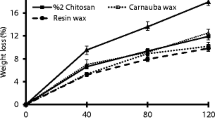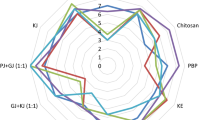Abstract
The objective of this study was to investigate the shelf life of arils and the changes in their biochemical compounds in nineteen Iranian pomegranate cultivars during storage. Fruits were harvested when commercially mature and the arils were removed, packaged and stored at 5 ± 1 °C, at 85–90% relative humidity in a cold room. Samples of the stored arils were examined for biochemical features in temporal checkpoints throughout a storage period that lasted for 35 days. By using the onset of decay as an index, the shelf life of arils varied among cultivars, ranging from 7 days to approximately 21 days. Considering the quality attributes of ready-to-eat arils at the beginning of the experiment, substantial variations were observed among the cultivars with regard to their titratable acidity (0.50–8.47%), total soluble solids (13–18.66 °Brix), DPPH radical scavenging activity (63–87.44%), Gallic-acid-equivalent (2.64–6.95 mg/ml) and ascorbic acid (12.21–75.09 mg/l). In general, the decay of arils gradually increased during storage, but several cultivars—which exhibited a very slow process of decay—contained the highest content of titratable acidity, Gallic-acid-equivalent and total soluble solids (since the signs of decay appeared on around the twenty-first day of storage). In addition, titratable acidity increased slightly by the end of storage, whereas the ascorbic acid content, total soluble solids and Gallic-acid-equivalent were cultivar-dependent and did not show consistent patterns of change during storage.

Similar content being viewed by others
References
Ayhan Z, Eştürk O (2009) Overall quality and shelf life of minimally processed and modified atmosphere packaged “ready-to-eat” pomegranate arils. J Food Sci 74:C399–C405
Bhatia K, Asrey R, Jha S, Singh S, Kannaujia PK (2013) Influence of packaging material on quality characteristics of minimally processed Mridula pomegranate (Punica granatum) arils during cold storage. Indian J Agric Sci 83:872–876
Bhatia K, Asrey R, Varghese E (2015) Correct packaging retained phytochemical, antioxidant properties and increases shelf life of minimally processed pomegranate (Punica granatum L.) arils Cv. Mridula. J Sci Ind Res 74(3):141–144
Caleb OJ, Opara UL, Mahajan PV, Manley M, Mokwena L, Tredoux AG (2013) Effect of modified atmosphere packaging and storage temperature on volatile composition and postharvest life of minimally-processed pomegranate arils (cvs. ‘Acco’and ‘Herskawitz’). Postharvest Biol Technol 79:54–61
D’Aquino S, Palma A, Schirra M, Continella A, Tribulato E, La Malfa S (2010) Influence of film wrapping and fludioxonil application on quality of pomegranate fruit. Postharvest Biol Technol 55:121–128
Defilippi BG, Whitaker BD, Hess-Pierce BM, Kader AA (2006) Development and control of scald on wonderful pomegranates during long-term storage. Postharvest Biol Technol 41:234–243
Dhinesh K, Ramasamy D (2016) Pomegranate processing and value addition. Rev J Food Process Technol. https://doi.org/10.4172/2157-7110.1000565
Ergun M (2012) Pomegranate. In: Siddiq M (ed) Tropical and subtropical fruits: postharvest physiology, processing and packaging. Wiley, New York, pp 529–548
Florkowski WJ, Prussia SE, Shewfelt RL, Brueckner B (2009) Postharvest handling: a systems approach, 2nd edn. Academic Press, San Diego
Ghasemnezhad M, Zareh S, Shiri MA, Javdani Z (2015) The arils characterization of five different pomegranate (Punica granatum) genotypes stored after minimal processing technology. J Food Sci Technol 52:2023–2032
Gil M, Artes F, Tomas-Barberan F (1996) Minimal processing and modified atmosphere packaging effects on pigmentation of pomegranate seeds. J Agric Food Chem 61:161–164
Haminiuk CW, Maciel GM, Plata-Oviedo MS, Peralta RM (2012) Phenolic compounds in fruits–an overview. Int J Food Sci Tech 47:2023–2044
Holland D, Bar-Ya’akov I (2008) The pomegranate: new interest in an ancient fruit. Chron Horticult 48:12–15
Holland D, Hatib K, Bar-Ya’akov I (2009) 2 Pomegranate: botany, Horticulture, Breeding. Hortic Rev 35:127–191
Institute S (2003) SAS version 9.1. SAS Institute, Cary
Jalikop S, Kumar PS (1990) Use of a gene marker to study the mode of pollination in pomegranate (Punica granatum L.). J Hortic Sci 65:221–223
Kamel HM, Zeinab AZ, Eman AAA (2015) The effect of propolis and sodium metabisulfite as postharvest treatments on pomegranate arils storage. Am-Eurasian J Agric Environ Sci 15:1962–1973
Kannan S, Susheela TA (2002) Effect of osmotic dehydration of guava. South Indian Hort 50:195–199
Karav S, Arikal AO, Eksi A (2015) Effect of cold storage of various pomegranate cultivars fruit juices on health promoting compounds and their activities. J Food Nutr Res 3:593–598
Kazemi M, Aran M, Zamani S (2011) Effect of salicylic acid treatments on quality characteristics of apple fruits during storage. Am J Physiol 6:113–119
Leistner L, Gould GW (2012) Hurdle technologies: combination treatments for food stability, safety and quality. Springer, New Yourk
Levin GM (1994) Pomegranate (Punica granatum) plant genetic resources in Turkmenistan. Plant Genet Resour Newsl (IPGRI/FAO)
Mazza G, Miniati E (1993) Anthocyanins in fruits, vegetables, and grains. CRC Press, Boca Raton
Mirdehghan SH, Rahemi M, Serrano M, Guillén F, Martínez-Romero D, Valero D (2006) Prestorage heat treatment to maintain nutritive and functional properties during postharvest cold storage of pomegranate. J Agric Food Chem 54:8495–8500
Moon JH, Terao J (1998) Antioxidant activity of caffeic acid and dihydrocaffeic acid in lard and human low-density lipoprotein. J Agricl Food Chem 46(12):5062–5065
Reyes LF, Villarreal JE, Cisneros-Zevallos L (2007) The increase in antioxidant capacity after wounding depends on the type of fruit or vegetable tissue. Food Chem 101:1254–1262
Roy S, Waskar D (1997) Pomegranate in postharvest physiology and storage of tropical and subtropical fruits. Cab International, Wallingford
Sayyari M, Valero D, Babalar M, Kalantari S, Zapata PJ, Ma Serrano (2010) Prestorage oxalic acid treatment maintained visual quality, bioactive compounds, and antioxidant potential of pomegranate after long-term storage at 2 C. J Agric Food Chem 58:6804–6808
Shwartz E, Glazer I, Bar-Ya’akov I, Matityahu I, Bar-Ilan I, Holland D, Amir R (2009) Changes in chemical constituents during the maturation and ripening of two commercially important pomegranate accessions. Food Chem 115:965–973
Silva IMBR, Rocha RHC, de Souza Silva H, dos Santos Moreira I, de Sousa FDA, de Paiva EP (2015) Qualidade e vida útil pós-colheita de romã ‘Molar’orgânica produzida no semi-árido paraibano. Semina: Ciências Agrárias 36:2555–2564
Singh B, Singh JP, Kaur A, Singh N (2018a) Antimicrobial potential of pomegranate peel: a review. Int J Food Sci Technol. https://doi.org/10.1111/ijfs.13964
Singh B, Singh JP, Kaur A, Singh N (2018b) Phenolic compounds as beneficial phytochemicals in pomegranate (Punica granatum L.) peel: a review. Food Chem 261:75–86
Singleton V, Rossi JA (1965) Colorimetry of total phenolics with phosphomolybdic-phosphotungstic acid reagents. Am J Enol Viticult 16:144–158
Tehranifar A, Zarei M, Nemati Z, Esfandiyari B, Vazifeshenas MR (2010) Investigation of physico-chemical properties and antioxidant activity of twenty Iranian pomegranate (Punica granatum L.) cultivars. Sci Hortic 126:180–185
Yassin N, Tayel EA (2009) Thermal post harvest treatments for improving pomegranate fruit quality and shelf life. Alexandria Sci Exch J 30(4):461–470
Zahran AA, Hassanein RA, AbdelWahab AT (2015) Effect of chitosan on biochemical composition and antioxidant activity of minimally processed ‘Wonderful’ pomegranate arils during cold storage. J Appl Bot Food Qual 88:241–248
Funding
This research is funded by Shiraz University (the affiliated institute of the authors) and there is no external funding for this research.
Author information
Authors and Affiliations
Corresponding author
Ethics declarations
Conflict of interest
The authors declare that they have no conflict of interest.
Additional information
Publisher's Note
Springer Nature remains neutral with regard to jurisdictional claims in published maps and institutional affiliations.
Rights and permissions
About this article
Cite this article
Ghasemi Soloklui, A.A., Gharaghani, A., Oraguzie, N. et al. Shelf life and biochemical changes of ready-to-eat arils among nineteen Iranian pomegranate cultivars (Punica granatum L.) during storage. J Food Sci Technol 56, 1416–1426 (2019). https://doi.org/10.1007/s13197-019-03620-0
Revised:
Accepted:
Published:
Issue Date:
DOI: https://doi.org/10.1007/s13197-019-03620-0




